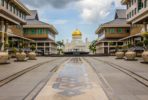A trend of increasing religiosity is taking hold in the Asia-Pacific region, while North America and Europe are experiencing the reverse with a projected spike in the proportion of people unaffiliated with any religion, showed a recent report by Washington-based think-tank Pew Research Centre.
In Singapore, Islam and Hinduism are projected to make the highest gains, with Muslims replacing Christians as the second-largest faith group by 2050. The report, The Future Of World Religions: Population Growth Projections, 2010-2050, was published on Thursday.
Pew’s researchers took six years to analyse information from about 2,500 data sources, including censuses, demographic surveys, general population surveys and other studies. Demographic projections made in the report were also based on the current size and geographic distribution of the world’s major religions, age differences, fertility and mortality rates, international migration and patterns in conversion between religions.
The report projected that in the Asia-Pacific region, the proportion of freethinkers is projected to decline from 21 per cent in 2010 to 17 per cent in 2050. Over the same period, the proportion of this group in Europe and North America is expected to increase from 19 per cent to 23 per cent, and from 17 per cent to almost 26 per cent, respectively.
“Atheists, agnostics and other people who do not affiliate with any religion — though increasing in countries such as the United States and France — will make up a declining share of the world’s total population,” it added.
The report also projected that the number of Muslims, a comparatively youthful population with high fertility rates, will nearly equal the number of Christians by 2050, if current demographic trends continue. As of 2010, Christians made up nearly a third of all 6.9 billion people on Earth. Muslims were the next largest group, comprising about 23 per cent.
The report projected Singapore’s total population to reach 7.9 million in 2050. The proportion of Muslims is projected to increase from 14.3 per cent in 2010 to 21.4 per cent in 2050, overtaking Christians as the second-largest group behind Buddhists. Over the same period, Singapore’s proportion of Hindus is expected to rise from 5.2 to 10.0 per cent. The report said the increases were “mostly because of migration from India and Malaysia”.
By 2050, freethinkers will make up 16 per cent of the total population, down slightly from 16.4 per cent in 2010. Over the same period, the proportion of Christians and Buddhists here will decrease from 18.2 to 17 per cent, and 33.9 to 27 per cent, respectively.
Commenting on the report, observers here questioned the assumption that migration patterns will continue over the next few decades.
Dr Mathew Mathews, a senior research fellow at the Institute of Policy Studies (IPS), pointed out that the Government had previously said it wanted to preserve the current racial balance. “Muslims and Hindus in Singapore usually are Malays and Indians, and if their racial composition is supposed to stay the same as currently, it will be unlikely that Islam and Hinduism in Singapore will grow substantially considering the current population plans,” he said.
The Pew report acknowledged that estimating future migration is challenging because the movement of people across borders is dependent on government policies and international events that can change quickly. “And because many migrants follow economic opportunities, migration patterns are also dependent on changing economic conditions,” it added.
Nonetheless, Pew said it has developed a technique to estimate recent migration patterns and their religious breakdown, in collaboration with researchers at Austria’s International Institute for Applied Systems Analysis.
In Singapore’s case, IPS senior research fellow Leong Chan-Hoong and Chua Chu Kang GRC Member of Parliament Zaqy Mohamad said it cannot be assumed that people migrating from Malaysia are probably Muslims. Stressing the challenges of migration projections, Dr Leong said migrants could come from different countries or involve different races or religions within a particular country.
Mr Zaqy said any increase in the Muslim and Hindu populations could also be because of a higher number of interracial marriages.
Should the projections come to pass, Singapore Management University law don Eugene Tan said Singapore may also have to look into building more places of worship for Muslims and Hindus. Likewise, there would also be an impact on the relative influence each religious group has on changes, where bigger groups could feel their views should carry more weight, for instance, he added.
Source: www.todayonline.com







